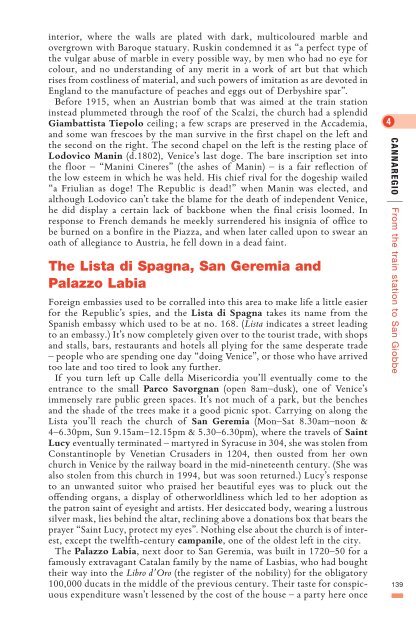You also want an ePaper? Increase the reach of your titles
YUMPU automatically turns print PDFs into web optimized ePapers that Google loves.
interior, where <strong>the</strong> walls are plated with dark, multicoloured marble <strong>and</strong><br />
overgrown with Baroque statuary. Ruskin condemned it as “a perfect type of<br />
<strong>the</strong> vulgar abuse of marble in every possible way, by men who had no eye for<br />
colour, <strong>and</strong> no underst<strong>and</strong>ing of any merit in a work of art but that which<br />
rises from costliness of material, <strong>and</strong> such powers of imitation as are devoted in<br />
Engl<strong>and</strong> <strong>to</strong> <strong>the</strong> manufacture of peaches <strong>and</strong> eggs out of Derbyshire spar”.<br />
Before 1915, when an Austrian bomb that was aimed at <strong>the</strong> train station<br />
instead plummeted through <strong>the</strong> roof of <strong>the</strong> Scalzi, <strong>the</strong> church had a splendid<br />
Giambattista Tiepolo ceiling; a few scraps are preserved in <strong>the</strong> Accademia,<br />
<strong>and</strong> some wan frescoes by <strong>the</strong> man survive in <strong>the</strong> first chapel on <strong>the</strong> left <strong>and</strong><br />
<strong>the</strong> second on <strong>the</strong> right. <strong>The</strong> second chapel on <strong>the</strong> left is <strong>the</strong> resting place of<br />
Lodovico Manin (d.1802), <strong>Venice</strong>’s last doge. <strong>The</strong> bare inscription set in<strong>to</strong><br />
<strong>the</strong> floor – “Manini Cineres” (<strong>the</strong> ashes of Manin) – is a fair reflection of<br />
<strong>the</strong> low esteem in which he was held. His chief rival for <strong>the</strong> dogeship wailed<br />
“a Friulian as doge! <strong>The</strong> Republic is dead!” when Manin was elected, <strong>and</strong><br />
although Lodovico can’t take <strong>the</strong> blame for <strong>the</strong> death of independent <strong>Venice</strong>,<br />
he did display a certain lack of backbone when <strong>the</strong> final crisis loomed. In<br />
response <strong>to</strong> French dem<strong>and</strong>s he meekly surrendered his insignia of office <strong>to</strong><br />
be burned on a bonfire in <strong>the</strong> Piazza, <strong>and</strong> when later called upon <strong>to</strong> swear an<br />
oath of allegiance <strong>to</strong> Austria, he fell down in a dead faint.<br />
<strong>The</strong> Lista di Spagna, San Geremia <strong>and</strong><br />
Palazzo Labia<br />
Foreign embassies used <strong>to</strong> be corralled in<strong>to</strong> this area <strong>to</strong> make life a little easier<br />
for <strong>the</strong> Republic’s spies, <strong>and</strong> <strong>the</strong> Lista di Spagna takes its name from <strong>the</strong><br />
Spanish embassy which used <strong>to</strong> be at no. 168. (Lista indicates a street leading<br />
<strong>to</strong> an embassy.) It’s now completely given over <strong>to</strong> <strong>the</strong> <strong>to</strong>urist trade, with shops<br />
<strong>and</strong> stalls, bars, restaurants <strong>and</strong> hotels all plying for <strong>the</strong> same desperate trade<br />
– people who are spending one day “doing <strong>Venice</strong>”, or those who have arrived<br />
<strong>to</strong>o late <strong>and</strong> <strong>to</strong>o tired <strong>to</strong> look any fur<strong>the</strong>r.<br />
If you turn left up Calle della Misericordia you’ll eventually come <strong>to</strong> <strong>the</strong><br />
entrance <strong>to</strong> <strong>the</strong> small Parco Savorgnan (open 8am–dusk), one of <strong>Venice</strong>’s<br />
immensely rare public green spaces. It’s not much of a park, but <strong>the</strong> benches<br />
<strong>and</strong> <strong>the</strong> shade of <strong>the</strong> trees make it a good picnic spot. Carrying on along <strong>the</strong><br />
Lista you’ll reach <strong>the</strong> church of San Geremia (Mon–Sat 8.30am–noon &<br />
4–6.30pm, Sun 9.15am–12.15pm & 5.30–6.30pm), where <strong>the</strong> travels of Saint<br />
Lucy eventually terminated – martyred in Syracuse in 304, she was s<strong>to</strong>len from<br />
Constantinople by Venetian Crusaders in 1204, <strong>the</strong>n ousted from her own<br />
church in <strong>Venice</strong> by <strong>the</strong> railway board in <strong>the</strong> mid-nineteenth century. (She was<br />
also s<strong>to</strong>len from this church in 1994, but was soon returned.) Lucy’s response<br />
<strong>to</strong> an unwanted sui<strong>to</strong>r who praised her beautiful eyes was <strong>to</strong> pluck out <strong>the</strong><br />
offending organs, a display of o<strong>the</strong>rworldliness which led <strong>to</strong> her adoption as<br />
<strong>the</strong> patron saint of eyesight <strong>and</strong> artists. Her desiccated body, wearing a lustrous<br />
silver mask, lies behind <strong>the</strong> altar, reclining above a donations box that bears <strong>the</strong><br />
prayer “Saint Lucy, protect my eyes”. Nothing else about <strong>the</strong> church is of interest,<br />
except <strong>the</strong> twelfth-century campanile, one of <strong>the</strong> oldest left in <strong>the</strong> city.<br />
<strong>The</strong> Palazzo Labia, next door <strong>to</strong> San Geremia, was built in 1720–50 for a<br />
famously extravagant Catalan family by <strong>the</strong> name of Lasbias, who had bought<br />
<strong>the</strong>ir way in<strong>to</strong> <strong>the</strong> Libro d’Oro (<strong>the</strong> register of <strong>the</strong> nobility) for <strong>the</strong> obliga<strong>to</strong>ry<br />
100,000 ducats in <strong>the</strong> middle of <strong>the</strong> previous century. <strong>The</strong>ir taste for conspicuous<br />
expenditure wasn’t lessened by <strong>the</strong> cost of <strong>the</strong> house – a party here once<br />
Cannaregio From <strong>the</strong> train station <strong>to</strong> San Giobbe<br />
|<br />
139







